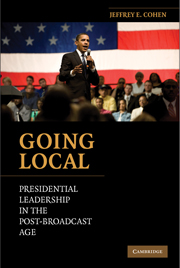Book contents
- Frontmatter
- Contents
- List of Figures
- List of Tables
- Introduction
- 1 Context and Presidential Leadership Styles
- 2 Increasing Presidential Attention to Narrow Groups
- 3 Presidents and the Local News Media
- 4 A Theory of Presidential News Management and Local News Coverage
- 5 The Quantity of Local Newspaper Coverage of the President
- 6 Trends in Local Newspaper Coverage of the Presidency, 1990–2007
- 7 On the Tone of Local Presidential News
- 8 Local Presidential News Coverage and Public Attitudes toward the President
- 9 Conclusions: Presidential Leadership in the Post-Broadcast Age
- Bibliography
- Index
4 - A Theory of Presidential News Management and Local News Coverage
Published online by Cambridge University Press: 05 June 2012
- Frontmatter
- Contents
- List of Figures
- List of Tables
- Introduction
- 1 Context and Presidential Leadership Styles
- 2 Increasing Presidential Attention to Narrow Groups
- 3 Presidents and the Local News Media
- 4 A Theory of Presidential News Management and Local News Coverage
- 5 The Quantity of Local Newspaper Coverage of the President
- 6 Trends in Local Newspaper Coverage of the Presidency, 1990–2007
- 7 On the Tone of Local Presidential News
- 8 Local Presidential News Coverage and Public Attitudes toward the President
- 9 Conclusions: Presidential Leadership in the Post-Broadcast Age
- Bibliography
- Index
Summary
The previous chapters argue that local newspapers have become increasingly important to presidential communications and support building efforts in the late twentieth and early twenty-first centuries. In the post-broadcast age, presidents found that the national leadership style, used with some success from the 1950s into the 1970s, was no longer as potent at mobilizing mass publics support and building support coalitions. Hence, presidents developed a revised going public style to accommodate to the realities and constraints of the post-broadcast age. This revised or updated going public style targets the president's partisan base, specific interest groups, and select localities.
Local newspapers may be especially important to the president in targeting localities. As argued in Chapter 3, local newspapers are attractive to presidents because they still command a relatively large audience; they are still highly respected, especially compared with the national news media; and they present measurable amounts of news on the president, especially in comparison to local television. Local newspapers may be the most potent medium for presidential communications efforts targeted at localities.
But local newspapers will be useful to presidents only if they are able to affect the news that is published about them. Whether presidents can “manage” their local news is an empirical question; the next several chapters test the ability of presidents to affect certain important characteristics of presidential news in local newspapers. This chapter presents the theoretical foundation for the analysis that follows.
- Type
- Chapter
- Information
- Going LocalPresidential Leadership in the Post-Broadcast Age, pp. 71 - 88Publisher: Cambridge University PressPrint publication year: 2009



